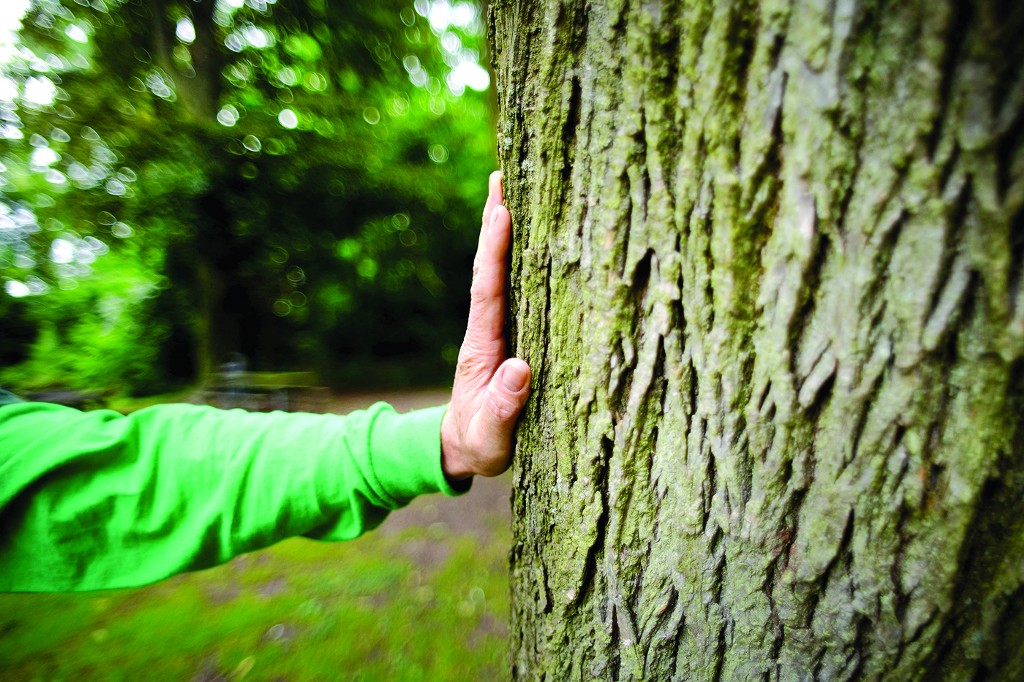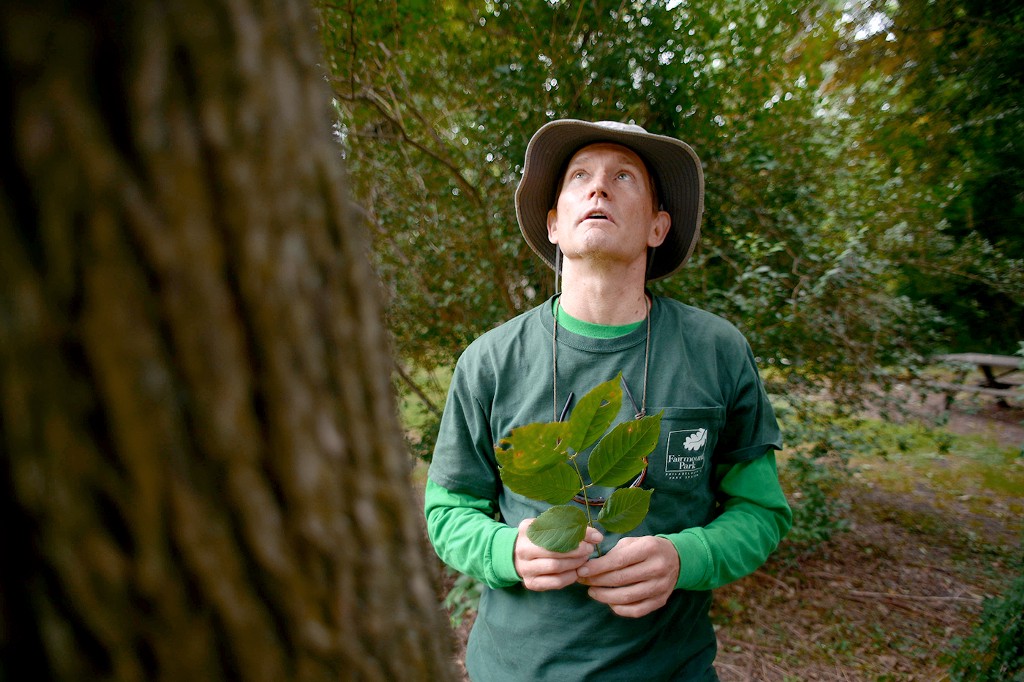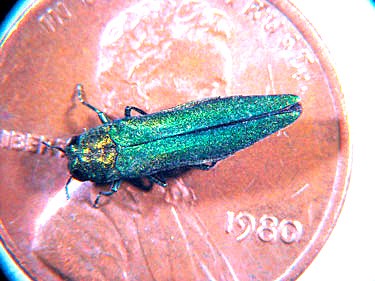The emerald ash borer. PHOTO COURTESY OF WIKIMEDIA
A glistening green insect no larger than a penny is poised to wipe out an entire species of Philadelphia’s trees, and people may be powerless to stop the historic onslaught, according to a Fairmount Park forester.
The insidious emerald ash borer will likely be here before we realize it and could devastate 126,000 ash trees in all parts of the city, said Curtis W. Helm, the project manager for urban forestry and ecosystem management with the city’s Department of Parks and Recreation. There are actually two primary species of ash in the city, green and white. Both are vulnerable to the borer.
“It’s been described by foresters in the Midwest as a tidal wave,” Helm told the Northeast Times during a July 25 walk around the Fairmount Park Horticultural Center. “Trees get overwhelmed and killed almost simultaneously in an area.”
Last year, Helm authored the 30-page Emerald Ash Borer Management Plan for the city, which identified the insect as an invasive pest that originated in Asia. American scientists first observed the flying bug in Detroit in 2002. It probably had made its way overseas in wooden shipping pallets. Since then, it has spread to at least 16 U.S. states and three Canadian provinces. It’s been seen in at least 31 Pennsylvania counties and was detected in Warrington, Bucks County, in March 2012. Helm described the bug’s arrival in Philadelphia as “imminent.”
People are largely responsible for its migration.
“The insect on its own wouldn’t move very fast, a couple of miles a year maybe, whichever way the wind is blowing,” Helm said. “But people pick up firewood, put it in their campers, drive hundreds of miles and set up their camps. Then the insects emerge.”
The insect thrives on all North American ash species, of which there may be 126,000 or more in the city’s 11,407 acres of watershed parks (including Pennypack, Tacony Creek and Poquessing Creek parks in the Northeast) and smaller developed parks, as well as privately owned residential and commercial properties. Based on a decade-old U.S. Forest Service study, park officials believe that ash trees account for up to six percent of the city’s tree cover. A new survey is in progress. Because the invasive borer evolved independently from native ash trees, the plants are defenseless to the insect.
“In Asia, there’s a balance between the insect and the tree. [In America], there’s no relationship that’s been established over the millennia,” Helm said.
According to the forester, the borer literally chokes the life out of mature ash trees, which typically grow up to 80 feet tall and can live for hundreds of years. In early summer, the females lay their eggs on the trunk, usually in the upper portion of the trees where the bark is thinner. The eggs hatch within a couple of weeks, then the larvae bore through the bark to feed on the cambium layer. That’s the relatively thin layer of the tree that produces new bark and where nutrients and moisture circulate.
A single tree can be infested with hundreds of larvae, which devour the cambium in serpentine patterns and block the tree’s circulatory system.
“Because so many [insects] feed on the tree simultaneously, they block its ability to move what it needs through its system,” Helm said.
After wintering inside the outer layers of the tree, the mature insects will bore out of the tree in the spring, leaving D-shaped exit holes in the bark. They can fly immediately and mate, restarting the reproduction cycle. People may not notice the infestation of an area for a few years because the insects often do their work high overhead and the signs of decline in the tree are subtle at first.
Healthy ash trees are recognizable for their compound leaf structure. It has five, seven or nine leaves on each petiole or stalk, similar to walnut trees. Also, the bark has an elongated-diamond-shaped pattern, while the limbs and branches have an opposite-branching pattern, meaning that branches sprout in pairs directly opposite from one another.
The trees are noted for producing a lot of seeds, which feed local wildlife, and are critical components to the urban forest canopy. They help reduce flooding and produce oxygen. In addition, they provide raw material for baseball bats.
An infected tree will have stunted growth. Its canopy won’t be as dark green as a healthy tree and the leaf coverage will be sparser. It will have dead or dying branches and dead twigs that will fall to the ground. New sprouts will shoot from unusual places on the tree, such as the base of the trunk. This indicates that nutrients are not reaching the upper, infected area of the tree. Removing the bark in an infected area of a tree will reveal serpentine markings created by the insect’s feeding pattern. Also, there may be an increase in woodpecker activity around infected trees. The birds feed on the larvae.
“It’s like a smorgasbord for woodpeckers. That’s how these infestations get discovered,” Helm said.
In recent weeks, the Department of Parks and Recreation has deployed a team of graduate interns into city parks, including Pennypack Park in the Northeast, to survey and tag ash populations. The tags are individually numbered medallions and are crucial to the city’s efforts to monitor and respond to the threat. There are no vast forests of ash in the city. Rather, the trees generally grow in small clusters or individually.
“If my interns find a cluster of trees that looks suspicious, they’ll notify me,” Helm said.
The city’s street tree maintenance workers are also on the lookout.
“The problem in Pennypack Park is that somebody has been removing tags [from the trees],” Helm said.
The city has not begun to identify any trees for pre-emptive removal, according to the park manager. But if and when infestation occurs, crews will likely have to remove trees that pose a safety threat to people and property if they fall.
“The ones we’re most concerned about are the ones that could be a problem if they die,” Helm said. ldquo;If you’re a homeowner, it’s the same [concern].”
For the long term, the city in partnership with the state’s Department of Conservation and Natural Resources plans to introduce organisms known as parasitoids that consume or kill the borers without harming native insects. But that can’t be done until the borers arrive. Spraying insecticides is not a practical option in the city. Other insecticides can be applied one tree at a time, but the process is costly and time-consuming. In case of near-total destruction of the mature ash tree population, public agencies have been collecting and preserving ash tree seeds in hope of reintroducing the species to the parks once the threat has passed.
“It’s nothing that we can really do much about other than to react to,” Helm said. “We’re just trying to plan for it.” ••

Bug bites: Curtis Helm, from the Department of Parks and Recreation, walks through a forest by the Fairmount Park Horticulture Center and points out trees threatened by the emerald ash borer. The invasive insect has been observed in Warrington, Bucks County. MARIA POUCHNIKOVA / TIMES PHOTO

Bug bites: Curtis Helm, from the Department of Parks and Recreation, walks through a forest by the Fairmount Park Horticulture Center and points out trees threatened by the emerald ash borer. The invasive insect has been observed in Warrington, Bucks County. MARIA POUCHNIKOVA / TIMES PHOTO





